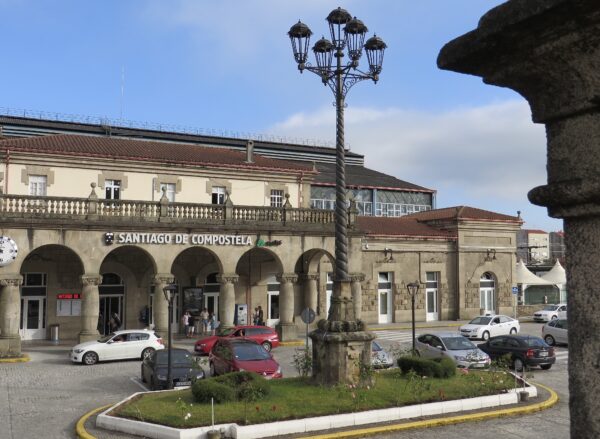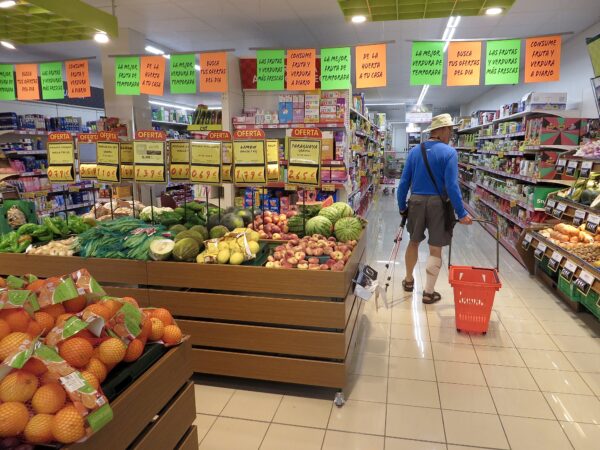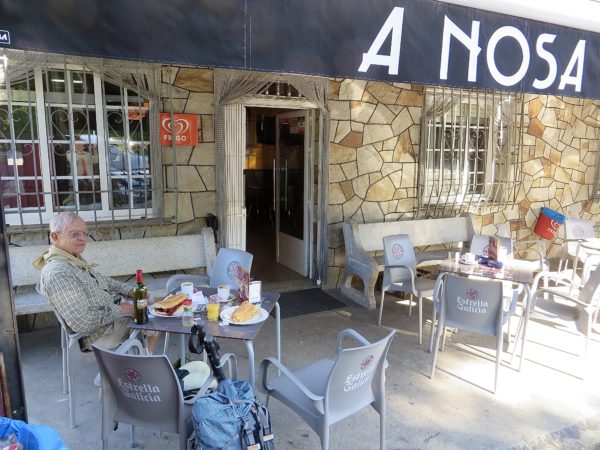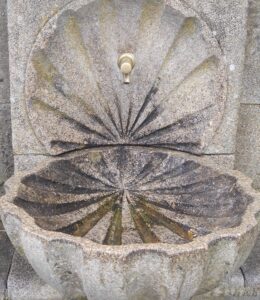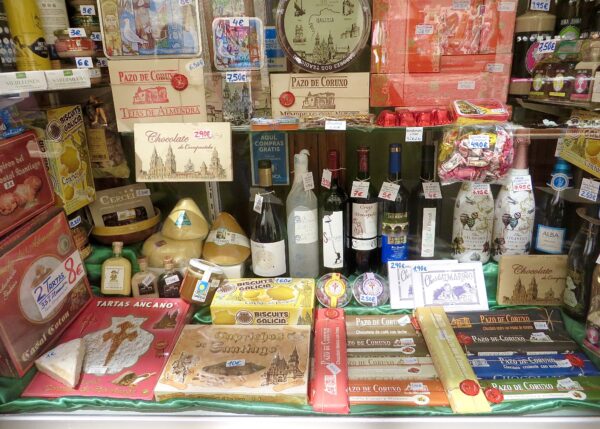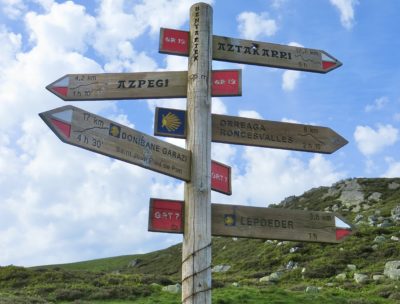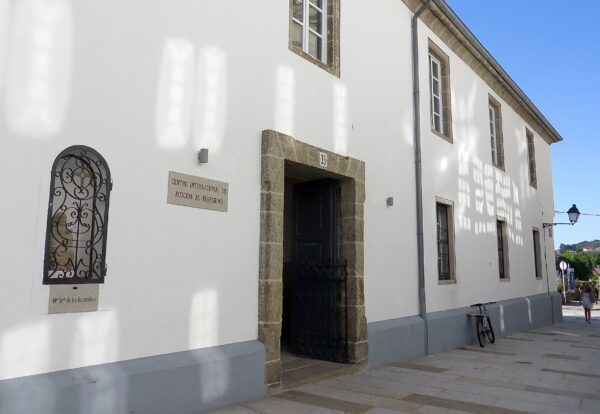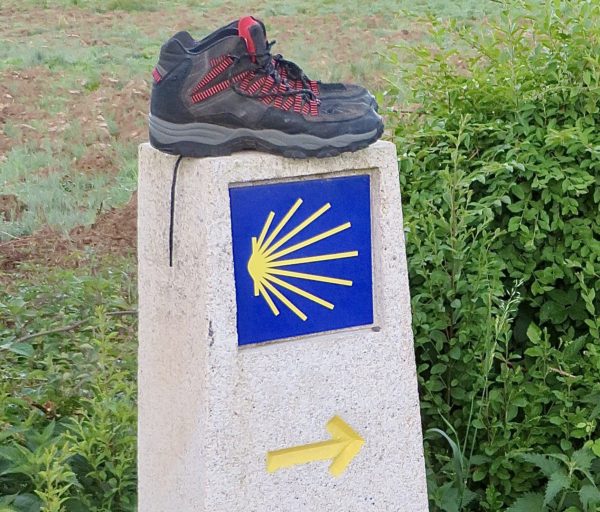Camino Resources: Planning a Camino walk, Part 2
The Santiago train station & the new bus station next to it are about a 20 minute walk from the Cathedral.
This page lists more resources begun on Camino Resources, Part I. Check out info below regarding transportation, food & water on the trail, and helpful tips for walking a Camino.
Transportation:
- Rome2Rio — good resource for finding out transportation possibilities.
- Arrival city (if flying) — What city you choose to fly into may depend on your walking plans & whether you’ll be traveling before/after a Camino. Airfare prices usually are also a big factor. Possible arrival cities for walks in Spain include Madrid & Barcelona. If you’re starting the walk in St. Jean Pied de Port, the closest airport city is Biarritz, France. However, it’s sometimes cheaper to fly into Madrid, etc. Another option is an “open jaws” flight itinerary, in which you arrive/depart from different cities. Some walkers choose to book ahead only their arrival flight and then wait to book their return until after the walk is underway. This works well for walkers with flexible schedules & time constraints, however, it could be more expensive than purchasing round trip tickets.
- Trains & buses — Spain’s train system is Renfe; the largest bus system is ALSA. Check out Omio (formerly GoEuro) for a list of other bus companies. Also, check out Trainline for discounted train & bus tickets (app available).
- Train tips & tickets — Check out Rick Steves for tips on European train travel, including in Spain. He also has a link for purchasing tickets in association with Rail Europe. Another resource is seat61.com, which lists info about train travel in Spain (and other countries) & has links for purchasing tickets too.
- Tarjeta Dorada — Or “Gold Card” that people age 60+ can purchase for around 6 Euros to receive a 25-40% discount on train rides. However, there are instances where the card doesn’t provide the best/cheapest option. For further info check out seat61.com & Rick Steves.
- Online tickets — Check out different sources if purchasing tickets online — costs may vary.
- Booking ahead — There are pros & cons to booking a train/bus ticket in advance. Although booking ahead is helpful if you have a tight time frame, online tickets may cost more. Also, if your flight was delayed and you miss the train/bus, it may be a hassle to get a refund or purchase a new ticket (check refund/exchange policies if booking ahead).
- Air travel — Flying is another transportation option to reach your starting point after arriving to Spain. It’s sometimes quicker, more convenient, & cheaper than trains/buses.
- Camino de Santiago Forum — The pilgrim forum (also listed in Camino Resources, Part 1) is a helpful resource for questions regarding transportation, including train & bus possibilities to specific locations.
- Train & bus tickets are available for purchase at the Pilgrim’s Office in Santiago — very convenient! However, if an event or festival is happening in Santiago, then transport options may be already booked up, so consider buying tickets in advance.
Snacks & basics are available at mercados & supermercados – even small towns usually have grocery shops.
Food & water:
- Packing food — There’s no need to carry your own food supply unless you plan on preparing meals while camping or when staying at albergues, which may or may not have kitchen facilities. Keep in mind carrying food adds weight to the backpack. Often extra food products are left behind at albergues — if you want to cook, check out what supplies are available in the kitchen (such as pasta, olive oil, etc.).
- Spanish “bars” — In Spain, bars are equal to cafes & serve as community gathering places. They’re essential to walkers for food, water, & beverages (and sometimes restrooms — see “Restrooms” in TOILETRIES & HEALTH under the “Camino tips & misc.” section below). Guidebooks/apps indicate where bars are located along the trail. Don’t mind any used napkins thrown on the floor — that’s the custom.
- Menu del Peregrino — Restaurants/bars usually offer a “pilgrim’s menu,” which includes 3 courses plus a choice of a bottle of water or wine for around 10-15 Euros. Two of the courses include selections such as salads, pastas, & meat dishes, often accompanied with French fries; course 3 is a choice of dessert (yoghurt, flan, etc.).
- Siesta hours — Remember that shops, restaurants, etc. in Spain are usually closed during siesta hours — generally between 2-5:00 p.m. or later.
- Communal meals — Some albergues offer meals cooked by the manager/hospitaleros — dishes include pasta, paella, etc. It’s a great opportunity to meet other walkers and share Camino stories.
- Camino dishes — Popular dishes include tortillas (baked potato & egg mixture similar to a quiche) and Padron peppers, which are roasted & sprinkled with sea salt — beware, there’s sometimes a hot pepper in the bunch!
- Tapas — From the Spanish word “to cover”; small plates of food similar to appetizers & available at many bars; they often include different toppings on bread like bruschetta. In the Basque region tapas are called “pintxos.”
- Jamón — Ham is a specialty in Spain and served in different ways, including in sandwiches (bocadillos) and as part of tapas.
- Tarta de Santiago — An almond cake with St. James’ cross stenciled on top with confectioners sugar — it’s a special Camino dessert that’s particularly popular in Galicia.
- ‘Fine dining’ — If interested in pricier ‘gourmet’ cuisine, check Camino guides/travel guidebooks/online resources for each region, including the Basque area known for its food. For wine connoisseurs, the La Rioja region is renowned for its vineyards.
A typical daily schedule is to walk for an hour or more in the morning & then stop for breakfast/brunch.
- Hydration — Keeping hydrated is essential while walking — it helps to avoid muscle cramps & strains, heat exhaustion, etc. Walkers replenish their water containers/camelbak bladders with water available at fuentes (public fountains) along the trail. Thus, there’s no need to carry gallons of water (although on ‘quieter’ routes fuentes could be limited & carrying more water will be necessary). Bars/restaurants are also good sources for water. Some walkers prefer to drink only bottled water.
- Fuentes — Water fountains are found in towns, at albergues, & sometimes “out in the middle of nowhere.” They come in different sizes, shapes, & materials, including stone. Guidebooks/apps usually indicate where fuentes are located, so you can gauge your water intake & how much to keep handy. A water bottle or two is typically enough to carry, depending on weather conditions and each walker’s hydration needs. Some people prefer using camelbak bladders for easy access to water while walking.
Camino tips & misc.:
CREDENCIALS & PILGRIM REGISTRY:
- Digital Credencial app — An app is now available to collect digital sellos by using QR (Quick Response) codes as an option to the traditional paper credencial. The app is offered in 8 languages for IOS & Android platforms. For more info check out the Correos & Pilgrim’s Office websites.
- Pilgrim Registry — In 2021 an online registry was created to expedite the process of receiving Compostelas. The registration form is on the Pilgrim’s Office website & also available on the Wise Pilgrim app. Or walkers can go to the Pilgrim’s Office & get their ticket. The ticket has a QR code that shows the status of the queue — you can either wait for your number to be called, or go & come back. It’s recommended to return in plenty of time so as not to miss your number (otherwise you may have to get a new ticket).
ROUTE INFO, ETC.:
- Rest days — Consider taking ‘rest days’ as part of your walking schedule to give your legs/feet a break, especially if you’re on the Road for weeks. If taking time off in a larger town, check out the Tourist Information office (usually marked as “i” on guidebook maps). They typically provide city maps for free and give info on historical sites, where to go for supplies, etc.
- Scout ahead — Locate where the Camino route leads out of town after you settle in at your lodging, so you’ll know where to go in the morning. This will be particularly important if you’re starting before dawn — finding markers/arrows in the dark is challenging.
- Camino tour companies — If interested in guided/self-guided Camino walks check out travel companies that organize trips & transport backpacks/luggage, such as On Foot in Spain, CaminoWays.com, Macs Adventures, etc. (Google to find more companies). **Before booking check out reviews & cancellation policies.
- Napoleon route to Roncevalles — If walking the Napoleon route from St. Jean to Roncevalles, consider taking the alternate trail from where the windmill & stone Camino marker are located. Turn right, and the path easily winds down the hill. In contrast, the path straight ahead from this spot is a steep descent through a tree grove — it can be slippery, especially in muddy conditions — some walkers have become injured trying to go down this way. See Brierley’s guidebook for more info.
MAILING GEAR & BACKPACK TRANSPORT:
- Sending packages ahead — Packages of unloaded gear, extra clothes, luggage, etc. can be mailed ahead to Casa Ivar run by Ivar Rekve in Santiago. Ivar also manages the Camino de Santiago forum.
- Backpack transport — If you’re unable to carry a backpack or prefer to walk without one there are van services available that transport packs to albergues (& packs/luggage to hotels, etc.). This service is typically 6-10 Euros per transfer. There are various transport companies for Camino Frances & Camino Portuguese, including Express Bourricot, which offers passenger transport too. Company contact info is often posted at albergues (ask for help if not), and it can be booked online as well.
- Correos services — Spain’s postal service (Correos) also transports packs & offers other services for walkers, including mailing packages of unloaded gear, etc. Ask for the “pilgrim rate” if sending packages ahead with Correos; packages are kept in Santiago for up to 45 days.
- *Transport caution* — Make sure there will be someone at your lodging to receive a backpack/luggage if you send it ahead to hotels, apartments, etc. — some lodging is “contactless” or “keyless,” which often means guests receive a code to use for entry into the building (transport services likely won’t have access to codes).
TOILETRIES & HEALTH:
- Pandemic news — For updates regarding COVID in Spain check out Expatica.
- Toiletries — Bring small sizes of shampoo, toothpaste, etc. instead of larger & heavier containers; refills are available in Spain at pharmacies (farmacias) & mercados/shops.
- Farmacias — Pharmacies are found in most towns of any size. They have medications, first-aid products, toiletries, elastic bandage wraps, etc.
- Hand sanitizer/wipes — Handy for hygiene while on the trail & when using public restrooms, which may not provide hand soap.
- Blisters — To prevent blisters consider bringing Vaseline to smear over feet before putting on socks; non-petroleum based Vaseline is available (Alba brand makes one). Check out the Camino de Santiago Forum for other blister prevention tips – different tips work for different feet.
- Blister ‘hot spots’ — If there are any points on the feet that are rubbing & creating friction apply Moleskin or Compeed to stop blisters from forming. Compeed is available at drugstores, online, and at farmacias in Spain. Cover hot spots right away rather than waiting until after blisters have formed.
- Restrooms — Some bars are a restroom source, although food/beverages should be bought out of courtesy (bring hand sanitizer/wipes as mentioned above) — more recently, however, there are reports that this option might not be as available anymore, especially in crowded Camino sections. The only restroom option could be to go behind a bush, tree, rock, etc., but watch for people passing by! If you use any toilet paper ‘out in nature’ put in plastic bag & dispose of properly (please don’t leave TP/waste behind).
- Medical help — Medical/dental services are typically available in larger towns. Cost varies, so make sure your travel insurance includes medical coverage that best serves your travel needs (see below in TRAVEL TIPS). Read about travel blogger Janet Hanpeter’s dental ‘emergency’ during her Camino in 2018.
Besides awarding Compostelas, the Pilgrim Office in Santiago offers postal service, bicycle parking, bathrooms, & train/bus ticket desks. The building complex includes a chapel, library, & a courtyard with a fountain.
More Camino tips & misc.:
MONEY & DOCUMENTS:
- Money belts — Important to use for passports, major money, credit/debit cards, copies of documents, etc. Wear your money belt under clothes out of sight (rather than storing it in the pack) to avoid losing it or having it stolen. If you’re staying at albergues, sleep with your money belt on for safekeeping.
- ATM cash withdrawals — Use ATMs located at banks only (or go inside for personal service). Take out the maximum amount per withdrawal to avoid paying more fees. Try to use ATMs during banking hours because if your card gets stuck someone inside will be available to retrieve it (yes, this happens!). Also, be aware of “skimming” at ATMs — Johnny Jet has an excellent article about how to avoid having your bank card skimmed.
- “Tap” payment — Contactless or “tap” payment with credit & debit cards is now common in Europe. Current cards should include this option — look for 4 curved lines like the Wifi symbol — just tap this symbol against the terminal. Another popular way to pay is with Apple Wallet (Apple Pay) on iPhones & Google Pay on Android; check online/YouTube videos for more info on this option.
- Money tips — Check out Rick Steves for tips on money & travel.
- Passport/documents — Bring a print copy of passport, drivers license, etc. in case anything is lost/stolen; keep in your money belt for safekeeping. Some walkers choose to scan/photograph documents and save as a pdf. Additionally, consider leaving print copies with a family member/friend as a backup.
- ETIAS (European Travel Information and Authorisation System) — Beginning mid-2025 U.S. citizens will need an ETIAS visa waiver for travel to European countries in the “Schengen Zone,” which includes Spain, Portugal, & France. Check the ETIAS website for further updates.
SAFETY INFO:
- Solo women walkers — Keep in mind your usual safety precautions while on the trail & traveling alone. Be observant of your surroundings, and use your intuition & instincts. Pair up with other walkers if there are any situations that don’t feel comfortable or safe. Remember that other walkers are usually happy to help with questions & concerns. Always report any ‘incidents,’ such as harassment, theft, etc. (see AlertCops below).
- AlertCops — Download this app to contact the police and report any incidents.
- Emergencies — “112” is the European emergency telephone number — English speakers will be available. A safety guidebook (in English) for pilgrims by the Xunta de Galicia (gov. agency of Galicia) includes 112 info.
TRAVEL TIPS:
- Carry on — When flying, consider ‘carrying on’ your backpack rather than checking it as baggage — you’ll avoid the chance of getting the pack lost enroute or having to wait to pick it up in baggage claim once landed.
- European travel info — Check out Rick Steves with links for “Travel Tips,” “Travel Talks,” etc.
- Travel insurance — ‘Don’t go on a trip without it.’ Travel insurance typically covers medical expenses, trip delays or cancellations, lost luggage, etc. Carefully check out options to choose what company/policy/price best serves your travel needs. Always look at reviews to avoid choosing a company/policy that may not offer reliable service. Travel insurance is also available through airlines when tickets are booked or before your flight; however, make sure their policy offers what you want. A CFAR (cancel for any reason) policy covers health related emergencies (such as an epidemic/pandemic) that other policies may not. Note that CFAR policies generally cost more.
ULTREIA ET SUSEIA:
- Journaling — Bring a small lightweight journal (or use your phone) to record daily experiences & walkers’ contact info to keep in touch. It’s easy to forget names, places, observations, & revelations, particularly if you’re on the Road for weeks.
- Camino ‘lessons’ — Every day on the Camino is a new adventure! Savor the experiences & discoveries — there’s a lot to learn. Observe local culture and the art & architecture that define the path’s history. Engage with the surroundings, and be in the moment.
- Post Camino — A long journey often brings changes, inspiration, & transformation once back home — from ‘lightening the load’ by cleaning out closets to finding new career paths, starting creative projects, deepening spiritual practices, etc. Or stopping more to “smell the flowers.” All walkers experience their own unique Caminos, and how the journey is processed afterwards will be individual too.

